The Period 1929-23
It was only a short time that the church with its headquarters at Waterloo carried the name of The Mennonite Refugee Church, for quite soon the people were dissatisfied with their refugee appellation and attempted to regard Canada as a new home. In keeping with this changed attitude the church was renamed The United Mennonite Church of Ontario. The word “United” was used because members originated from various regions and congregations in Russia. The various, geographically separated settlements in Russia had had little communication with one another except for the annual confederate assembly to which delegates from all congregations were sent. Indeed the communication gaps had given some settlements rather singular characteristics even though the distinctions between Flemish and Frisian were entirely lost in Russia. Still there were variations in methods of baptism, foot washing, and other religious rituals, although immersion as a baptismal form was never practiced by the General Conference congregations. Here in Ontario an agreement was reached on forms and ordinances; hence the name ‘United Mennonite Church’. The standard in many instances was provided by Rev. Jacob. H. Janzen, who had belonged to the Gnadenfeld congregation (Molotschna) in the old country.
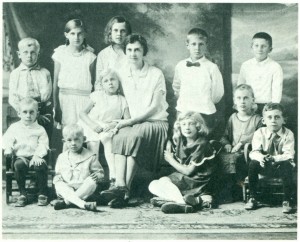
Here in Ontario, too, geographical separation was a reality with the Reesor church 650 miles north of Waterloo; Essex County and Pelee Island 200 miles south west of Waterloo. Rev. Janzen acted as link among them as he diligently travelled from one to the other and officiated at services of baptism, communion, etc. Occasionally representatives from the various areas would meet in lieu of general membership meetings.
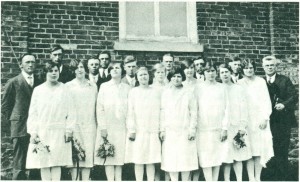
On one such meeting of church councils on January 20, 1929, unanimity was reached concerning the unfeasibility of maintaining the church as one unit any longer because of distance and growing numbers. Therefore at the same meeting one large church was divided into three smaller and fully independent units, the latter being:
- The Waterloo-Kitchener United Mennonite Church
- The Essex County United Mennonite Church
- The Reesor United Mennonite Church.
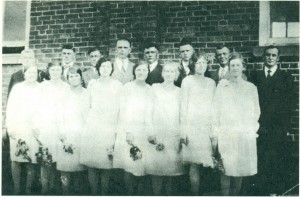
The Leamington United Mennonite Church thus had its birth on January 20, 1929. The name however of “Essex County United Mennonite Church” was retained until January I, 1958. In drawing the boundaries for the three smaller units the chief consideration was practicality. And so the highway between London and St. Thomas marked the boundary between Waterloo and Essex County. Families living at Port Alma and on Pelee Island automatically belonged to the Essex County congregation. To the Pelee Island Mennonites, numbering about 80, the arrangement was somewhat alien since some regarded Waterloo as their first loyalty. Nonetheless, the line had been drawn – and the islanders became a part of Leamington, a restructuring they had no reason to regret.
The division of the Waterloo church had at first only minimal consequences. Rev. J. H. Janzen continued to service the newly- established congregations. The administrative aspects of church life of course became much more disentangled. Membership figures for the Leamington congregation in 1929 are unknown, but two years later membership stood at 335.
Building a Church
The issue of constructing a church dragged on for several years before the structure finally became an actuality. In the intervening years a suitable meeting place had been discovered on Erie North, where CHYR radio now has its studios. In Kingsville the town hall stood ready for use on Sundays. In 1931 only Leamington and Kingsville remained as viable meeting sites with the exception of more outlying areas as Windsor, Harrow, and Pelee Island. But the adequacy of meeting halls in Leamington and Kingsville notwithstanding, the need existed for one’s own building. In Leamington, for instance, where membership was rather large, townspeople were somewhat chagrined when after a service the sidewalk became obstructed with worshippers. Then too men like Jacob and Henry Barkowsky, Henry Braun, and others had their difficulties in transporting chairs from the basement to the second floor and back again after the service. Yet to think seriously about building a church in times of economic depression was a disturbing experience. Nonetheless, several meetings aimed at building took place in 1932 and

1932. At one time consideration was given to purchasing an old hall in Ruthven, 25 x 64, for $2,500.00, but the location was unsuitable. Then there was a well-maintained barn, 40 x 78 on Erie Street North, near the railway tracks, available for $3,500, but again the location was poor and the cost too high for purchase and remodelling. In the face of these adversities some began looking about for a lot on which eventually a church might be built. This last effort came to fruition when one acre of land was purchased from Arthur Brown, on Oak Street East, the site of the present building. The price for this open piece of Mersea farmland was $700.00. At the time of purchase consideration was given for a burial ground near the building, and even though the Department of Health approved the idea, the plan was ultimately dropped.
The lot was ready now, but no building was on it. At a general membership meeting on December 13, 1931, a motion was passed to purchase the Catholic church on Elliott Street, a wooden structure, 28 x 40, for a price of $250.00 with moving $35.00 extra. After excavations for a basement and necessary repairs, the entire project would cost about $1,000.00 The motion to purchase was supported by 36 voters with 17 abstentions. After several weeks, however, word was received that the Catholic bishop in London had vetoed the sale of the building, and so, many efforts went for naught.
To receive an indication of how hesitant the membership was toward building, one needs only to glance at a list of pledges obtained at a meeting in 1931 – II pledges totalling $125.00. When pledges were to be transformed into cash, John Schroeder of Kingsville reported to a meeting on March I, 1931, that only $70.00 had been realized.
At a general membership meeting a fortnight later, a two-hour deliberation of 60 members produced the following results:
- Do you wish to build? Unanimous yes.
- When shall we begin? 26 immediately; 21 in the fall. (Some members obviously had departed early)
- Cost? $4,500.00 maximum.
- Method of financing? An equal levy on all members.
A committee elected to complete the legal transactions regarding the lot, and to search for other sources of revenue such as offerings so that a building can be erected. Elected were: Peter A. Hamm, Jacob Koop, Johann H. Schroeder, Kingsville. Also functioning on the committee: Jacob H. Funk, Peter P. Enns. Decisions were quickly made, but no building was done until two years later. Apparently a large part of the congregation was skeptical about it all and satisfied with existing conditions. That building eventually came about in the spring of 1933 was owing to the fortitude and efficiency of Rev. William J. Schellenberg and Abraham Willms. Both had had experience in construction and now offered themselves gratis to build the church provided the members worked for no wages when their assistance in building was required.
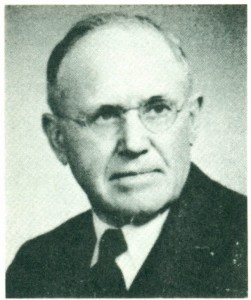
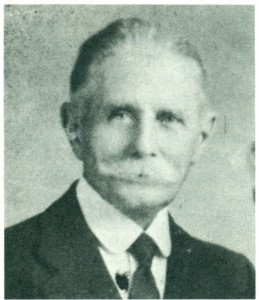
With hardly $100.00 in the building fund, the construction of the church had to be regarded as an act of faith.
The size of the building was to be 36 x 66 with a basement to house the Sunday school. The length included the six feet that were needed to include a chancel in the main sanctuary and a kitchen in the basement. One morning, then, Peter J. Enns (presently of 11/2 Garrison St.) could be seen handling a stately team of horses hitched to a scoop, which was guided by his step-father Jacob J. Toews. Both men were hard at work excavating the basement. A Russian proverb states “Potschien dorrozsche djenjeg”. (A beginning is more treasured than gold). The proverb certainly applied here. Peter Enns and his father began the actual physical labour connected with building although Rev. W. Schellenberg had done the measuring and staking previously.

Footings and basement walls were poured in the Holy Week of April 10-13, 1933. Then the building was abandoned until on a Monday morning, October 16, a small group gathered for prayer inside the basement walls before the construction work was renewed. On the photograph one will notice how bare and desolate the site appeared in the summer of 1933. Even when work was resumed the overall attitude was still one of reluctance, the belief being that the undertaking was too uncertain and perilous. Yet thanks to the courageous example of W. Schellenberg and A. Willms the work progressed and by Christmas the building was roughed in. Pews of course were made by members themselves, but one luxury item was allowed – electricity instead of gas lamps. The light fixtures incidentally are still in use today.
The first church service was held in the new basement on the day after Christmas in 1933, and services continued here until the nave upstairs was finally finished. The cost of the structure according to the minutes of January 28, 1934, was $2,148.00. The inner walls, however, were still unfinished as well as the ceiling and floor. By February 1, 1935, the cost had increased to $2,559.65 and on February 2, 1936, another $546.95 had been spent, making the total cost $3,106.60. Everyone was grateful for the accomplished endeavor and in spite of gnawing poverty the church was gradually paid for.
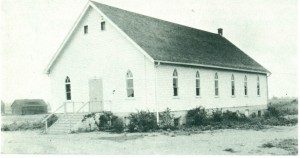
The plan of the church was quite uncomplicated, following guidelines that existed in Russia except that pointed Gothic windows instead of rectangular ones were used. (The watchword of simplicity in architecture dates back to the time of the Mennonite withdrawal from the Catholic Church. The latter had to make a pronounced impression on the worshippers. The Mennonites were opposed to symbols and embellishments, fearing that these might be taken as alternatives to a genuine, Christian worship. Thus their buildings were austere, without bell and belfry, and this severe simplicity also carried over to their religious services. Nothing was to blind man’s relationship with God.
The simplicity of church architecture in the early Mennonite church was also due to the directives of the governing state church. Rival churches were to be unattractive so that church-goers would be discouraged from attending (Menn. Life). Nowadays the Mennonites in many respects have adopted a style of living similar to that of the adjacent environment.)
Election of an Elder
By Waterloo report Rev. J. H. Janzen informed the congregations on July 21, 1931 that the General Conference of Mennonites in North America was no longer prepared to support its ministers financially and as a result he was resigning his office both in Leamington and Waterloo. Each congregation was now empowered to seek an Elder out of its own ranks. The news of the resignation was received withastonishment and regret in Leamington; yet despite promises of local support Rev. Janzen did not alter his decision, for he already had intentions to move to Vancouver to found a girls’ home among Mennonite families who had come from the prairies to Vancouver seeking work. Soon after the elections in Waterloo and Leamington, Rev. Janzen left for Vancouver, and the Reesor congregation was served by an Elder from Manitoba. After a number of years in Vancouver Rev. Janzen returned and served the church in Waterloo. The Waterloo-Kitchener church elected (summer of 1932) Rev. Dietrich H. Koop as its Elder. He had arrived the previous year from Manitoba and had purchased a fruit farm in Vineland. In Russia he had been a school teacher.
Perhaps an explanation should be made here concerning the word Elder. His was the highest spiritual position in the Mennonite Church, tracing back to biblical times where it is mentioned in Acts 14:23, I Tim. 5: 17, etc. The office was bestowed on Menno Simons in Groningen, Holland, in 1537, by Obbe Philips in the presence of Dirk Philips (Menn. Lexicon. B. III, Pg. 80). The office as with all other offices in the Mennonite Church, is an elected one, and almost to this day was the only office empowered to baptize, to break bread at communion, and to ordain church workers. In the Leamington church this practice still continues. In the almost 450-year history of the Mennonites the office surely has earned a rightful place and was at times an unqualified exigency. The Elders were given proper recognition and great authority in Holland and Northern Germany and later in 19th and 20th century Russia. (Menn. Ene. II. 180) For that reason their election was a most unusual occasion in the life of the church.
With regard to the Leamington election, after much wavering the entire complement of ministers was placed before the congregation as Elder candidates, and after a secret ballot involving all members Rev. Nicolai N. Driedger received a majority of votes. He had come to the mainland from Pelee Island in November 1930, settled in the Kingsville district, and had chiefly served the Kingsville Mennonites prior to his election.
Other Events from 1929-1933
- A notable occurrence in this period was the parting of ways with the Brethren Church. At first there had been very little contrast between the two persuasions, but as the Mennonite population increased resulting in further organization each felt a need for assembling separately. The initiative came from the Brethren Church, whose ministers proposed in the summer of 1932 that their members would be better acknowledged were services held among themselves. The proposal was accepted, but even though a division took place, relationships with the Brethren Church have generally remained cordial and amicable.
- Another occurrence was the increase in the ministerial staff, Rev. N. N. Driedger having come from the Island and Rev. W Schellenberg having come to Leamington from Windsor on October 8, 1930. Both were already members on arrival. For a short period Rev. Schellenberg was the leading minister of the Leamington church.
- A further development was an alteration in the method of taking offerings. In Russia an offering box was usually fastened somewhere near the church exit so that worshippers leaving the service might make a contribution. Here in Canada the usual method was to pass an offering plate along each pew; so when a change from the old was proposed the proposal at first met with some resistance. At first offerings were taken on no particular schedule except that once per month an offering was lifted for relief in Russia and later once per month for the church building fund. Two Sundays per month were usually open, a far cry from the tight offering schedule of today. On January 10, 1932, a motion was passed by the membership to announce openly the amount of each offering, a practice still in vogue today. In 1931 the budget of the church was $1427.83, including relief monies.
- The Leamington church in the course of 47 years has made us of three sets of hymnaries. The first came to Canada from Russia, most immigrant families having included one or two in their meagre packs. In parallel use was the so-called “Dreiband” hymnary of the Mennonite Brethren Church. When using the latter book, an M.B. custom was followed in which one or two lines of a hymn were first spoken by one person and then the same lines repeated in song by the congregation. The hymns selected had an easy-to-follow melody and a simple rhyme. The hymnary preferred, however, was the one from Russia because both the words and music contained herein had greater depth. Unfortunately, though, new copies were no longer available and so the Waterloo church through the particular efforts of Herman C. Enns had new books printed in Western Europe. Consequently, the hymnary brought from Russia was in use until about 1942. One drawback to the book was that it had no music to accompany the words. In Russia in 1860 a certain Henry Franz, a clever teacher, had written a four-part harmony music book as a supplement to the hymnary. Notes had been transposed to figures (Ziffern) to facilitate memorization. Any Mennonite student graduating from elementary school in Russia was acquainted with every melody in the supplement thus enabling him to participate in singing any song out of the hymnary. Here in Canada the musical supplements were few in number and so Rev. J. H. Janzen again assigned himself the task of typing the four- part music of the supplement, mimeographing the typed material, and assembling it into a neat booklet. With the assistance of Mr. Henry C. Huebert Sr. of Windsor he also revised the musical score. The booklet, however, did not enjoy the same success here as in Russia, where no school day went by without the practising of a hymn. With changing times the clear-sighted saw that an entirely new hymnary was needed. (A dedicated congregational song leader in the early thirties was Henry B. Wiens. who also served as Deacon since 1933.)
- A final development during the 4 years under consideration was the first sending of delegates to a Mennonite conference. Long before the arrival of the Mennonites in the twenties, there had been two conferences of General Conference persuasion, the Canadian Conference and the General Conference of Mennonites with headquarters in Newton, Kansas. The Ontario churches since their formation had belonged to both. In fact the General Conference did much in financially supporting the Russian Mennonites on their arrival, in maintaining Rev. J. H. Janzen for a time as well as other Elders in the West. and in sustaining girls’ homes, etc. In 1933 (August 28 – September 2) the General Conference had its sessions in Bluffton, Ohio, and since Bluffton was only 160 miles from Leamington, Wilhelm Schellenberg and N. N. Driedger were sent as delegates. Accompanying these two beginners was a third conference novice, Rev. Dietrich H. Koop, of Vineland. Proceedings at the conference were altogether unfamiliar to the Ontario group while contrarily, the Americans looked on their Canadian counterparts with wonder and unexpectedness. To add to their discomfort all three Ontario delegates were asked to address the assembly – in the German language of course. At that time German fortunately was still in use as an alternative language at the General Conference. Even the chairman, P. P. Wedel, and the secretary C. E. Krehbiel, made use of both German and English in addressing the assembly and in recording the minutes. C. E. Krehbiel had visited the Mennonites in Russia during the famine of 1922. Another interesting feature of the conference was that preceding every meal a song was sung by those about to be served. During the sessions one could sense some tension between modernism and fundamentalism albeit one did not fully understand the differences between the two. Another issue completely new to the Ontario delegates was the conference decision that members were to abstain from membership in lodges. And so charged with remarkable impressions the delegates returned to Leamington having spent one week in Bluffton. Throughout the conference there had been one nagging thought, however, of one’s family at home labouring in the Heinz tomato fields in an attempt to maintain a very frugal existence. Yet this kind of sacrifice was expected from an Elder. In 1935, N. Driedger was sent to Altona, the first Leamington delegate to a Canadian conference.
In summarizing the first decade one might generalize rather nostalgically by saying that the late twenties and early thirties in spite of want and privation were beautiful years. N0 event was taken for granted – neither the purchase of a used car nor a new item of clothing, neither the first choir practice nor the first social outing. The dedication of the new church in all its incompleteness was also emotionally moving. What today is dubbed monotony was then novel experience. Superfluity and leisure often result in boredom and ill-humor. What a blessing toil is when it is tempered with moderation and contentment!
